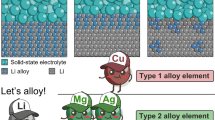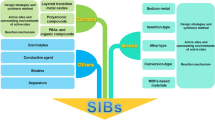Abstract
The positive electrode of a Li-ion battery is made from active material, a binder and conductive material. In this work, the direct and interaction effects of these components on electrochemical performance of a Li-ion cell is studied using design of experiments. For this purpose, a two-level full factorial design was used and interactions were analyzed using analysis of variance. The content of carbon black and graphite as conductive materials and polyvinylidene difluoride as binder are considered as input parameters. Theactive material is NCM622 in the current work. Initial discharge capacity and Warburg coefficient obtained from impedance spectroscopy are output responses. Eleven experiments along with the central points were conducted to determine the relationship between process parameters and the output responses. This information is needed to optimize the output. It was observed that all three parameters are significant. In low carbon black and graphite content, the binder has a negative effect on both parameters, but in high levels of carbon black content it has a positive effect due to the better connectivity of carbon particles with each other. The results show that interaction of carbon black-binder and carbon black-graphite are also significant. Mathematical models were presented in order to optimize the parameters.
Graphic Abstract

Similar content being viewed by others
References
F. Schipper and D. Aurbach, Russ. J. Electrochem. 52, 1095 (2016).
J.B. Goodenough and K. Park, J. Am. Chem. Soc. 135, 1167 (2013).
J. Maier, Angew. Chem. Int. 52, 4998 (2013).
M.S. Whittingham, Chem. Rev. 114, 11414 (2014).
W. Li, B. Song, and A. Manthiram, Chem. Soc. Rev. 46, 3006 (2017).
R. Chen, T. Zhao, X. Zhang, L. Li, and F. Wu, Nanoscale Horiz. 1, 423 (2016).
C. Julien, A. Mauger, K. Zaghib, and H. Groult, Materials 9, 595 (2016).
T.F. Yi, J. Mei, Y.R. Zhu, and J. Power, Sources 316, 85 (2016).
J. Ma, P. Hu, G. Cui, and L. Chen, Chem. Mater. 28, 3578 (2016).
C. Tian, F. Lin, and M. Doeff, Acc. Chem. Res. 51, 89 (2018).
D. Andre, S.J. Kim, P. Lamp, S.F. Lux, F. Maglia, O. Paschos, and B. Stiaszny, J. Mater. Chem. A 3, 6709 (2015).
C. Tian, J. Electrochem. 165, A696 (2018).
M. Ghorbanzadeh, E. Allahyari, R. Riahifar, and S.M.M. Hadavi, J. Solid State Electr. 22, 1155 (2018).
M. Ghorbanzadeh, E. Allahyari, R. Riahifar, and S.M.M. Hadavi, J. Appl. Electrochem. 48, 75 (2018).
D. Zuo, G. Tian, X. Li, D. Chen, and K. Shu, J. Alloys Compd. 706, 24 (2017).
Y.H. Chen, C.W. Wang, X. Zhang, and A.M. Sastry, J. Power Sources 195, 2851 (2010).
H. Zheng, R. Yang, G. Liu, X. Song, and V.S. Battaglia, J. Phys. Chem. C 116, 4875 (2016).
R. Dominko, M. Gaberscek, J. Drofenik, M. Bele, S. Pejovnik, and J. Jamnik, J. Power Sources 119, 770 (2003).
R. Dominko, M. Gaberšček, J. Drofenik, M. Bele, and S. Pejovnik, Electrochem. Solid-State Lett. 4, A187 (2002).
R. Dominko, M. Gaberscek, M. Bele, J. Drofenik, E.M. Skou, A. Wursig, P. Novak, and J. Jamnik, J. Electrochem. Soc. 151, A1058 (2004).
C.C. Li and Y.W. Wang, J. Electrochem. Soc. 158, A1361 (2011).
W. Bauer, D. Nötzel, V. Wenzel, and H. Nirschl, J. Power Sources 288, 359 (2015).
D. Guy, B. Lestriez, R. Bouchet, V. Gaudefroy, and D. Guyomard, Electrochem. Solid-State Lett. 8, A17 (2004).
H. Bockholt, M. Indrikova, A. Netz, F. Golks, and A. Kwade, J. Power Sources 325, 140 (2016).
Q. Zhang, Z. Yu, P. Du, and C. Su, Recent Pat. Nanotechnol. 4, 100 (2010).
M.E. Spahr, D. Goers, A. Leone, S. Stallone, and E. Grivei, J. Power Sources 196, 3404 (2011).
L. Fransson, T. Eriksson, K. Edström, T. Gustafsson, and J.O. Thomas, J. Power Sources 101, 1 (2001).
Y. Cao, L. Xiao, X. Ai, and H. Yang, Electrochem. Solid-State Lett. 6, A30 (2003).
X.L. Li, Y.L. Zhang, H.F. Song, K. Du, H. Wang, and J.M. Huang, Int. J. Electrochem. Sci. 7, 7111 (2012).
S.T. Taleghani, B. Marcos, K. Zaghib, and G. Lantagne, J. Electrochem. Soc. 164, E3179 (2017).
C.M. Doyle, T.F. Fuller, and J. Newman, J. Electrochem. Soc. 140, 1526 (1993).
D.C. Montgomery, Design and Analysis of Experiments (New York: Wiley, 1997).
L. Su, J. Zhang, C. Wang, Y. Zhang, Z. Li, Y. Song, T. Jin, and Z. Ma, Appl. Energy 163, 201 (2016).
R. Mathieu, I. Baghdadi, O. Briat, P. Gyan, and J. Vinassa, Energy 141, 2108 (2017).
E. Hosseinzadeh, J. Marco, and P. Jennings, Energies 10, 1278 (2017).
P. Xiao, T. Lv, X. Chen, and C. Chang, Sci. Rep. 7, 1 (2017).
J. Zhang, J. Wang, Y. Liu, N. Nie, J. Gu, F. Yu, and W. Li, J. Mater. Chem. A 3, 2043 (2015).
L. Wang, J. Zhao, X. He, J. Gao, J. Li, C. Wan, and C. Jiang, Int. J. Electrochem. Sci. 7, 345 (2012).
M. Ghorbanzadeh, S. Farhadi, R. Riahifar, and S.M.M. Hadavi, New J. Chem. 42, 3444 (2018).
Y.K. Lee, Energies 12, 658 (2019).
M. Zarei-jelyani, M. Babaiee, S. Baktashian, and R. Eqra, J. Solid State Electrochem. 23, 2771 (2019).
C.K. Park, S. Bin Park, S. Oh, H. Jang, and W. Cho, Bull. Korean Chem. Soc. 32, 836 (2011).
Author information
Authors and Affiliations
Corresponding author
Ethics declarations
Conflict of interest
The authors declare that they have no conflict of interest.
Additional information
Publisher's Note
Springer Nature remains neutral with regard to jurisdictional claims in published maps and institutional affiliations.
Rights and permissions
About this article
Cite this article
Fathi, A.R., Riahifar, R., Raissi, B. et al. Optimization of Cathode Material Components by Means of Experimental Design for Li-Ion Batteries. J. Electron. Mater. 49, 6547–6558 (2020). https://doi.org/10.1007/s11664-020-08413-2
Received:
Accepted:
Published:
Issue Date:
DOI: https://doi.org/10.1007/s11664-020-08413-2




